Meiosis is a specialized type of cell division that reduces the chromosome number by half, essential for sexual reproduction and genetic diversity. This process involves two successive divisions, resulting in four genetically unique haploid cells. Discover how meiosis drives inheritance and variation by reading the rest of the article.
Table of Comparison
| Feature | Meiosis | Karyokinesis |
|---|---|---|
| Definition | Type of cell division producing four haploid cells from one diploid cell | Process of nuclear division during cell division |
| Purpose | Sexual reproduction and genetic diversity | Separation of replicated chromosomes into daughter nuclei |
| Phases | Two consecutive divisions: Meiosis I and Meiosis II | Includes prophase, metaphase, anaphase, telophase |
| Resulting Cells | Four genetically distinct haploid cells | Two nuclei with identical chromosome number as parent cell |
| Occurrence | Germ cells in sexually reproducing organisms | Both mitosis and meiosis |
| Genetic Variation | Introduces variation via crossing over and independent assortment | No genetic variation introduced |
Introduction to Meiosis and Karyokinesis
Meiosis is a specialized type of cell division that reduces the chromosome number by half, producing four haploid cells essential for sexual reproduction, while karyokinesis refers to the division of a cell's nucleus during both mitosis and meiosis. Meiosis consists of two sequential stages, meiosis I and meiosis II, each with distinct phases that ensure genetic diversity through processes like crossing over and independent assortment. Karyokinesis is critical for evenly segregating duplicated chromosomes into daughter nuclei, enabling accurate genetic transmission during cell division.
Definition of Meiosis
Meiosis is a specialized form of cell division that reduces the chromosome number by half, producing four genetically diverse haploid cells essential for sexual reproduction. Karyokinesis refers to the process of nuclear division where chromosomes are separated into daughter nuclei during both mitosis and meiosis. While meiosis includes two sequential rounds of karyokinesis, its primary function is generating gametes with half the original chromosome count, ensuring genetic variation.
Definition of Karyokinesis
Karyokinesis is the process of nuclear division during cell division, where the cell's chromosomes are equally separated into two daughter nuclei. This process is essential for both mitosis and meiosis, ensuring genetic material is accurately distributed. Meiosis differs from karyokinesis by incorporating two successive divisions, reducing chromosome number by half to produce haploid gametes.
Stages of Meiosis Explained
Meiosis consists of two successive divisions, Meiosis I and Meiosis II, each with distinct stages: prophase, metaphase, anaphase, and telophase. In Meiosis I, homologous chromosomes pair and exchange genetic material through crossing over during prophase I, followed by their separation in anaphase I. Meiosis II resembles mitotic karyokinesis, where sister chromatids separate, resulting in four haploid daughter cells essential for sexual reproduction.
Phases of Karyokinesis
Karyokinesis, the process of nuclear division during cell division, consists of distinct phases: prophase, metaphase, anaphase, and telophase. In prophase, chromatin condenses into visible chromosomes and the nuclear envelope dissolves; metaphase aligns chromosomes at the cell's equatorial plate; anaphase separates sister chromatids toward opposite poles; and telophase re-forms nuclear envelopes around each set of chromosomes. Unlike meiosis, which includes two sequential rounds of division producing four haploid cells, karyokinesis specifically refers to the division of the nucleus within both mitotic and meiotic processes.
Key Differences Between Meiosis and Karyokinesis
Meiosis is a specialized type of cell division that reduces the chromosome number by half, resulting in four genetically diverse haploid cells, crucial for sexual reproduction. Karyokinesis refers to the process of nuclear division during both mitosis and meiosis, ensuring accurate segregation of chromosomes into daughter nuclei. Key differences include meiosis involving two sequential divisions (meiosis I and II) leading to genetic variation, whereas karyokinesis is simply the nuclear division phase without necessarily reducing chromosome number or creating diversity.
Biological Significance of Meiosis
Meiosis is crucial for generating genetic diversity through homologous recombination and independent assortment, which ensures variation in offspring and contributes to evolution. Unlike karyokinesis, which is the process of nuclear division in mitosis and meiosis, meiosis specifically reduces the chromosome number by half, enabling sexual reproduction and maintaining genomic stability across generations. This reduction division prevents chromosome doubling in each generation and supports the formation of haploid gametes essential for genetic continuity.
Functional Role of Karyokinesis
Karyokinesis is the critical process of nuclear division that ensures accurate distribution of duplicated chromosomes into daughter nuclei, maintaining genetic stability during cell division. It functions primarily during mitosis and meiosis by orchestrating chromosomal alignment, separation, and movement through stages such as prophase, metaphase, anaphase, and telophase. This precise mechanical partitioning supports genetic continuity and variation, especially vital in meiosis for producing haploid gametes essential for sexual reproduction.
Meiosis vs Karyokinesis: Comparison Table
Meiosis and karyokinesis are distinct cellular processes, with meiosis involving two sequential nuclear divisions that reduce chromosome number by half, producing four haploid cells essential for sexual reproduction. Karyokinesis refers broadly to the division of a cell's nucleus during mitosis or meiosis, ensuring accurate chromosome segregation. A comparison table highlights meiosis's role in genetic variation and gamete formation versus karyokinesis's function in nuclear division regardless of the specific cell cycle phase.
Conclusion and Summary
Meiosis is a specialized cell division that reduces the chromosome number by half, producing four genetically diverse haploid cells, while karyokinesis refers specifically to the process of nuclear division during both mitosis and meiosis. Meiosis involves two rounds of karyokinesis (meiosis I and II), ensuring genetic variation through crossing over and independent assortment, which is absent in simple karyokinesis. In summary, meiosis encompasses karyokinesis but serves a unique role in reproductive cell formation, contrasting with the general nuclear division in somatic cell cycles.
Meiosis Infographic

 libterm.com
libterm.com